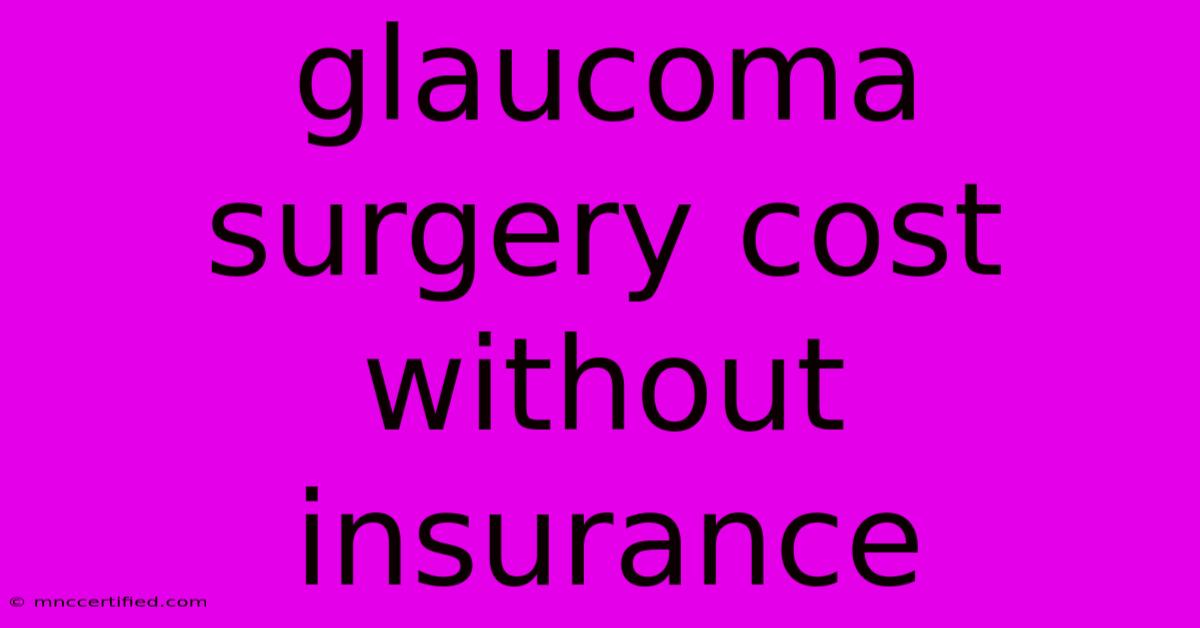Glaucoma Surgery Cost Without Insurance

Table of Contents
Glaucoma Surgery Cost Without Insurance: A Comprehensive Guide
Glaucoma, a serious eye condition that can lead to blindness, often requires surgery to manage its progression. If you're facing the prospect of glaucoma surgery and lack health insurance, understanding the costs involved is crucial. This guide will delve into the financial aspects of glaucoma surgery without insurance, providing you with valuable insights to navigate this potentially overwhelming situation.
Understanding Glaucoma Surgery Costs
The cost of glaucoma surgery without insurance varies greatly depending on several factors:
- Type of surgery: Different surgical procedures are used to treat glaucoma, with each carrying its own price tag. Common types include:
- Trabeculectomy: This traditional surgery creates a new drainage pathway for fluid in the eye.
- Laser Trabeculoplasty: This procedure uses a laser to open the drainage channels in the eye.
- Selective Laser Trabeculoplasty (SLT): This targeted laser treatment focuses on specific cells in the drainage system.
- Micro-invasive Glaucoma Surgery (MIGS): These minimally invasive procedures are often preferred for their faster recovery time and lower risk profile.
- Surgeon's fees: Surgeon expertise, experience, and location all influence the cost of their services.
- Facility fees: The surgical facility's location, amenities, and reputation can impact the total cost.
- Anesthesia fees: Whether you require general anesthesia or local anesthesia will factor into the overall bill.
- Post-operative care: Follow-up appointments, medications, and other necessary care add to the cost.
Factors Affecting Cost Without Insurance
While it's impossible to give a precise cost estimate without a consultation, here are some general estimations:
- Trabeculectomy: $3,000 to $5,000 per eye
- Laser Trabeculoplasty: $1,000 to $2,000 per eye
- SLT: $1,500 to $2,500 per eye
- MIGS procedures: $2,000 to $4,000 per eye
These figures represent a wide range, so it's critical to consult with multiple ophthalmologists and surgical centers to obtain personalized quotes.
Navigating the Financial Landscape
Facing glaucoma surgery without insurance can be daunting, but there are strategies to manage the costs:
- Financial Assistance: Some surgical centers offer financial assistance programs for uninsured patients. Inquire about these options before proceeding.
- Payment Plans: Many facilities accept payment plans to make the cost more manageable. Explore these options and understand the terms and conditions.
- Crowdfunding: Utilize online platforms to raise funds from family, friends, and the community.
- Second Opinions: Always seek a second opinion to confirm the diagnosis and treatment plan. This may lead to alternative, potentially less expensive, options.
- Vision Care Charities: Organizations like the Lions Club International Foundation provide financial assistance for vision care, including surgery. Research and explore these resources.
Conclusion
While the financial burden of glaucoma surgery without insurance can be significant, understanding the cost factors, exploring available resources, and actively seeking options can help you navigate this challenging situation. Remember, prompt diagnosis and treatment are crucial for preserving your vision, and prioritizing your eye health is essential even when facing financial constraints.

Thank you for visiting our website wich cover about Glaucoma Surgery Cost Without Insurance. We hope the information provided has been useful to you. Feel free to contact us if you have any questions or need further assistance. See you next time and dont miss to bookmark.
Featured Posts
-
Porn Addiction North Korean Soldiers After Access
Nov 08, 2024
-
Jeff Davis Insurance Jennings Louisiana
Nov 08, 2024
-
Outer Banks Season 5 What We Know
Nov 08, 2024
-
Public Transportation Insurance Carriers
Nov 08, 2024
-
Medicare Insurance Agents Wilmington Nc
Nov 08, 2024